ecf7cb028cfc00282a138220d37a9ed5.ppt
- Количество слайдов: 119
 The Spectrum of Concierge Care: Scientific, Ethical, and Policy Issues Martin Donohoe
The Spectrum of Concierge Care: Scientific, Ethical, and Policy Issues Martin Donohoe
 Am I Stoned? A 1999 Utah anti-drug pamphlet warns: “Danger signs that your child may be smoking marijuana include excessive preoccupation with social causes, race relations, and environmental issues”
Am I Stoned? A 1999 Utah anti-drug pamphlet warns: “Danger signs that your child may be smoking marijuana include excessive preoccupation with social causes, race relations, and environmental issues”
 n“All men are created equal” n. Declaration of Independence n“Some people are more equal than others” n. George Orwell
n“All men are created equal” n. Declaration of Independence n“Some people are more equal than others” n. George Orwell
 Outline n Financial problems facing academic medical centers n Single specialty hospitals n Medical tourism n Recruitment of wealthy, non-U. S. citizens
Outline n Financial problems facing academic medical centers n Single specialty hospitals n Medical tourism n Recruitment of wealthy, non-U. S. citizens
 Outline n Other competitive strategies n Overseas clinics/hospitals n Boutique/concierge/luxury care clinics n Erosion of science n Erosion of professional ethics n Solutions
Outline n Other competitive strategies n Overseas clinics/hospitals n Boutique/concierge/luxury care clinics n Erosion of science n Erosion of professional ethics n Solutions
 Academic Medical Centers Hurting Financially n US health care crisis n Costs associated with medical training n Disproportionate share of complex and/or uninsured patients
Academic Medical Centers Hurting Financially n US health care crisis n Costs associated with medical training n Disproportionate share of complex and/or uninsured patients
 Academic Medical Centers Hurting Financially n Erosion of infrastructure n Shrinking funding base n Increased competition with more efficient private and community hospitals
Academic Medical Centers Hurting Financially n Erosion of infrastructure n Shrinking funding base n Increased competition with more efficient private and community hospitals
 Single Specialty Hospitals n Over 100 nationwide n Often physician-owned n PPACA limits physician-owned hospitals from starting or expanding n Provision being challenged in courts n Boom from 2000 -2010, now on decline
Single Specialty Hospitals n Over 100 nationwide n Often physician-owned n PPACA limits physician-owned hospitals from starting or expanding n Provision being challenged in courts n Boom from 2000 -2010, now on decline
 Single Specialty Hospitals n Problems: Cherry pick healthier patients with good coverage n No ER n No need to cross-subsidize indigent care, ER, burn wards, and mental health care n Incentives for overtreatment n >1/3 may violate Medicare’s conditions for participation n
Single Specialty Hospitals n Problems: Cherry pick healthier patients with good coverage n No ER n No need to cross-subsidize indigent care, ER, burn wards, and mental health care n Incentives for overtreatment n >1/3 may violate Medicare’s conditions for participation n
 Medical Tourism US citizens traveling abroad for care n 750, 000 in 2007 n 1. 4 million in 2016 n vs. 800, 000 non-Americans visiting the U. S. annually for care in 2015 n Estimated $439 billion industry (2015) n
Medical Tourism US citizens traveling abroad for care n 750, 000 in 2007 n 1. 4 million in 2016 n vs. 800, 000 non-Americans visiting the U. S. annually for care in 2015 n Estimated $439 billion industry (2015) n
 Medical Tourism n n n Insurance plans increasingly cover (large cost savings) Mostly for cardiac, orthopedic, and cosmetic procedures Sometimes for pharmaceuticals or procedures unavailable or illegal US (e. g. , PAS) Adverse effects on health care availability in foreign countries May contribute to spread of infectious diseases n E. g. , NDM-1 per some scientists, others
Medical Tourism n n n Insurance plans increasingly cover (large cost savings) Mostly for cardiac, orthopedic, and cosmetic procedures Sometimes for pharmaceuticals or procedures unavailable or illegal US (e. g. , PAS) Adverse effects on health care availability in foreign countries May contribute to spread of infectious diseases n E. g. , NDM-1 per some scientists, others
 Reproductive Tourism 20, 000 to 25, 000 IVF procedures on US citizens done abroad n Rent-a-womb abuses n n n India, 25, 000 children/yr, surrogacy unregulated Converse situation is “maternity tourism” – undocumented immigrants entering U. S. to give birth (to babies guaranteed citizenship by the 14 th Amendment)
Reproductive Tourism 20, 000 to 25, 000 IVF procedures on US citizens done abroad n Rent-a-womb abuses n n n India, 25, 000 children/yr, surrogacy unregulated Converse situation is “maternity tourism” – undocumented immigrants entering U. S. to give birth (to babies guaranteed citizenship by the 14 th Amendment)
 Transplant Tourism n Transplant Tourism: Black market for organs (10 -25% of all kidneys transplanted worldwide each year) n Spurred on by marked organ scarcity in US n Stem cell tourism increasing n n Many procedures highly experimental, of dubious benefit (and possibly harm) n Hundreds of companies operating in US (regulation weak) n Clinical and ethical issues of treating patients post-op
Transplant Tourism n Transplant Tourism: Black market for organs (10 -25% of all kidneys transplanted worldwide each year) n Spurred on by marked organ scarcity in US n Stem cell tourism increasing n n Many procedures highly experimental, of dubious benefit (and possibly harm) n Hundreds of companies operating in US (regulation weak) n Clinical and ethical issues of treating patients post-op
 Competitive Strategies Increase alliances with pharmaceutical and biotech industries n Recruit wealthy, non-U. S. citizens as patients n Open hospitals in other countries n But non-profit hospitals flourishing n Tax breaks; net income up; subsidized care as low as 2 -3% of total expenses in many (or 1/2 of profits) n
Competitive Strategies Increase alliances with pharmaceutical and biotech industries n Recruit wealthy, non-U. S. citizens as patients n Open hospitals in other countries n But non-profit hospitals flourishing n Tax breaks; net income up; subsidized care as low as 2 -3% of total expenses in many (or 1/2 of profits) n
 Competitive Strategies n More aggressive billing practices / charging the uninsured higher prices n Average 2. 5 X what most health insurers pay and > 3 times actual costs n Result: class action suits n PPACA outlaws
Competitive Strategies n More aggressive billing practices / charging the uninsured higher prices n Average 2. 5 X what most health insurers pay and > 3 times actual costs n Result: class action suits n PPACA outlaws
 Competitive Strategies n Increase cash services (botox treatments, cosmetic surgery) and reimbursable, covered services (e. g. , cardiac catheterization, bone density testing) n High end maternity suites
Competitive Strategies n Increase cash services (botox treatments, cosmetic surgery) and reimbursable, covered services (e. g. , cardiac catheterization, bone density testing) n High end maternity suites
 Competitive Strategies n Cut back on uncovered services: e. g. , ER staffing n “Triaging out” – redirecting low acuity patients from ER to “other facilities” University of Chicago overturned policy in response to protests (2009) n ACEP and AAEM opposes such policies n
Competitive Strategies n Cut back on uncovered services: e. g. , ER staffing n “Triaging out” – redirecting low acuity patients from ER to “other facilities” University of Chicago overturned policy in response to protests (2009) n ACEP and AAEM opposes such policies n
 Competitive Strategies Advertising n Often promote high-paying, unproved, or cosmetic services n Arch Int Med 2005; 165: 645 -51 n Outsource radiology/transcription services to physicians in developing world n e. g. , MGH and Yale X-rays → India (they have since ended agreements) n Privacy, quality concerns n
Competitive Strategies Advertising n Often promote high-paying, unproved, or cosmetic services n Arch Int Med 2005; 165: 645 -51 n Outsource radiology/transcription services to physicians in developing world n e. g. , MGH and Yale X-rays → India (they have since ended agreements) n Privacy, quality concerns n
 Competitive Strategies n Pay sports teams for privilege of being team doctors (in return for free publicity) n Methodist Hospital – Houston Texans n NYU Hospital for Joint Diseases – NY Mets n Develop luxury primary care clinics n AKA “executive health clinics”, “boutique medicine”, “concierge care”, “VIP clinics”
Competitive Strategies n Pay sports teams for privilege of being team doctors (in return for free publicity) n Methodist Hospital – Houston Texans n NYU Hospital for Joint Diseases – NY Mets n Develop luxury primary care clinics n AKA “executive health clinics”, “boutique medicine”, “concierge care”, “VIP clinics”
 Recruitment of Wealthy Non-US Citizens Estimated 800, 000 patients/yr n Estimated 1 -2% of hospitals’ revenues n Number estimated to quadruple in next few years n Recruitment worldwide n Hospitals forming consortia to target certain countries, including those with national health plans n
Recruitment of Wealthy Non-US Citizens Estimated 800, 000 patients/yr n Estimated 1 -2% of hospitals’ revenues n Number estimated to quadruple in next few years n Recruitment worldwide n Hospitals forming consortia to target certain countries, including those with national health plans n
 Recruitment of Wealthy Non-US Citizens n Doctors sent on overseas speaking and recruitment tours n Patients offered rapid access to state-of-the -art care
Recruitment of Wealthy Non-US Citizens n Doctors sent on overseas speaking and recruitment tours n Patients offered rapid access to state-of-the -art care
 Recruitment of Wealthy Non-US Citizens n Payment at “retail rate, ” well above what government and private insurance reimburse n Immediate access to face-to-face translators n Only spottily available to uninsured, non -English speaking patients
Recruitment of Wealthy Non-US Citizens n Payment at “retail rate, ” well above what government and private insurance reimburse n Immediate access to face-to-face translators n Only spottily available to uninsured, non -English speaking patients
 Recruitment of Wealthy Non-US Citizens n Patients have not paid taxes in support of medical education and health care subsidies n The federal government spends about $20 billion/yr to pay medical schools and teaching hospitals for medical education and training n State and local governments provide $2 -3 billion/yr in additional subsidies
Recruitment of Wealthy Non-US Citizens n Patients have not paid taxes in support of medical education and health care subsidies n The federal government spends about $20 billion/yr to pay medical schools and teaching hospitals for medical education and training n State and local governments provide $2 -3 billion/yr in additional subsidies
 Recruitment of Wealthy Non-US Citizens n Health needs may not be as pressing (and are usually more costly) than the needs of those living in poverty in their home countries n Academic medical centers often refuse non -emergent care to non-US citizen refugees and undocumented immigrants
Recruitment of Wealthy Non-US Citizens n Health needs may not be as pressing (and are usually more costly) than the needs of those living in poverty in their home countries n Academic medical centers often refuse non -emergent care to non-US citizen refugees and undocumented immigrants
 Overseas Clinics and Hospitals n Academic medical centers owning and/or operating clinics and hospitals overseas n Substantially lower costs (most surgeries 50 -90% less expensive) n Many hospitals accredited, staffed by U. S. trained physicians
Overseas Clinics and Hospitals n Academic medical centers owning and/or operating clinics and hospitals overseas n Substantially lower costs (most surgeries 50 -90% less expensive) n Many hospitals accredited, staffed by U. S. trained physicians
 Overseas Clinics and Hospitals n AMA guidelines exist n Regulations imperfect n Risks include lack of follow-up, exposure to regional infectious diseases, limited malpractice options
Overseas Clinics and Hospitals n AMA guidelines exist n Regulations imperfect n Risks include lack of follow-up, exposure to regional infectious diseases, limited malpractice options
 Overseas Clinics and Hospitals n Examples: n Cleveland Clinic: Abu Dhabi, UAE n Duke University: Duke-National University of Singapore n Johns Hopkins: Cancer center in Singapore International Medical Center
Overseas Clinics and Hospitals n Examples: n Cleveland Clinic: Abu Dhabi, UAE n Duke University: Duke-National University of Singapore n Johns Hopkins: Cancer center in Singapore International Medical Center
 Overseas Clinics and Hospitals n Examples: n Harvard, Mayo Clinic : Dubai n Cornell-Weill Medical College: Qatar n University of Pittsburgh: transplant center in Palermo, Sicily, Italy n MD Anderson Cancer Center: MD Anderson International-España in Madrid, Spain
Overseas Clinics and Hospitals n Examples: n Harvard, Mayo Clinic : Dubai n Cornell-Weill Medical College: Qatar n University of Pittsburgh: transplant center in Palermo, Sicily, Italy n MD Anderson Cancer Center: MD Anderson International-España in Madrid, Spain
 Boutique Medicine Retainer Fee Medical Practice n Large/expensive vs. small/less expensive (sometimes for the uninsured) n Qliance n Premier Care, Valet Care, VIP Care, Gold Care, Platinum Care n Luxury Primary Care / Executive Health Clinics n
Boutique Medicine Retainer Fee Medical Practice n Large/expensive vs. small/less expensive (sometimes for the uninsured) n Qliance n Premier Care, Valet Care, VIP Care, Gold Care, Platinum Care n Luxury Primary Care / Executive Health Clinics n
 Boutique Medicine n Medi-Spas Cosmetic procedures, massage, aromatherapy, cosmeceutical sales n Generate over $1 billion annually in US n Travel medicine clinics for exotic destinations n Direct sales to patients of health and nutritional products, home laboratory and genome testing kits n
Boutique Medicine n Medi-Spas Cosmetic procedures, massage, aromatherapy, cosmeceutical sales n Generate over $1 billion annually in US n Travel medicine clinics for exotic destinations n Direct sales to patients of health and nutritional products, home laboratory and genome testing kits n
 Urgent Care Clinics n 9, 300 nationwide n 3 million visits /wk n Could avert 1/5 ER visits
Urgent Care Clinics n 9, 300 nationwide n 3 million visits /wk n Could avert 1/5 ER visits
 Other Specialized Primary Care Clinics n n n On-site corporate clinics n 1, 200 companies host 2, 200 clinics n Serve 4% of working Americans Telemedicine/videomedicine )advice lines, cannot prescribe, increasingly common overseas (take U. S. calls) n Numerous US organizations now offer virtual visits (costs vary) Self-service kiosks/video visits
Other Specialized Primary Care Clinics n n n On-site corporate clinics n 1, 200 companies host 2, 200 clinics n Serve 4% of working Americans Telemedicine/videomedicine )advice lines, cannot prescribe, increasingly common overseas (take U. S. calls) n Numerous US organizations now offer virtual visits (costs vary) Self-service kiosks/video visits
 Retail Outlet Clinics n Retail outlet clinics increasing n Majority are CVS Minute Clinics and Wal. Greens Take Care Clinics n Wal. Mart and Target also involved n Some have links with other health care systems)
Retail Outlet Clinics n Retail outlet clinics increasing n Majority are CVS Minute Clinics and Wal. Greens Take Care Clinics n Wal. Mart and Target also involved n Some have links with other health care systems)
 Retail Outlet Clinics n Retail outlet clinics n Approximately 2, 400 n Number may increase with PPACA (due to lack of primary care providers) n Almost 2/3 of current customers have no PCP n Hopes for increasing stores’ profits through sales of merchandise, over-priced pharmaceuticals n Most not profitable
Retail Outlet Clinics n Retail outlet clinics n Approximately 2, 400 n Number may increase with PPACA (due to lack of primary care providers) n Almost 2/3 of current customers have no PCP n Hopes for increasing stores’ profits through sales of merchandise, over-priced pharmaceuticals n Most not profitable
 Retail Outlet Clinics n Study of visits for OM, pharyngitis, and UTI n Ann Int Med 2009; 151: 321 -8. Quality same as in physician offices and urgent care clinics, better than in ER (although not clear if serious diagnoses missed) n Prescription costs similar n Overall costs significantly lower n Convenience factor n
Retail Outlet Clinics n Study of visits for OM, pharyngitis, and UTI n Ann Int Med 2009; 151: 321 -8. Quality same as in physician offices and urgent care clinics, better than in ER (although not clear if serious diagnoses missed) n Prescription costs similar n Overall costs significantly lower n Convenience factor n
 Retail Outlet Clinics n Problems include n Fragmentation of care n Incomplete records n Inadequate communication with PCPs n Lost opportunity for ongoing contact with PCP n Less common in low SES and minority neighborhoods n May increase inappropriate antibiotic prescribing n AAP says avoid retail clinics; AAFP has partnered with CVS
Retail Outlet Clinics n Problems include n Fragmentation of care n Incomplete records n Inadequate communication with PCPs n Lost opportunity for ongoing contact with PCP n Less common in low SES and minority neighborhoods n May increase inappropriate antibiotic prescribing n AAP says avoid retail clinics; AAFP has partnered with CVS
 Factors Which Might Encourage Retainer Fee Medical Practice J Clin Ethics 2005(Spring): 72 -84 Tight office schedules, long delays for appointments, short visit lengths n Authorization requirements of insurance companies, HMOs, and Medicare n Insufficient time to return phone calls n Non-reimbursable n
Factors Which Might Encourage Retainer Fee Medical Practice J Clin Ethics 2005(Spring): 72 -84 Tight office schedules, long delays for appointments, short visit lengths n Authorization requirements of insurance companies, HMOs, and Medicare n Insufficient time to return phone calls n Non-reimbursable n
 Factors Which Might Encourage Retainer Fee Medical Practice Congested ERs, with long delays for patients with minor illnesses who are unable to access PCP n Patients referred to specialists for problems that do not necessarily require a specialist’s care n Specialist referrals up outside luxury care, partly due to busy, short PCP visits n PCP burnout n
Factors Which Might Encourage Retainer Fee Medical Practice Congested ERs, with long delays for patients with minor illnesses who are unable to access PCP n Patients referred to specialists for problems that do not necessarily require a specialist’s care n Specialist referrals up outside luxury care, partly due to busy, short PCP visits n PCP burnout n
 Factors Which Might Encourage Retainer Fee Medical Practice n Frequent changes in PCP, abetted by: Hospitalist movement n Employers seeking cheaper plans, which provide narrower range of coverage n Insurance company de-listing of physicians based on economic criteria n Physician extenders (NPs and Pas) n Less time for patient-care advocacy n Less time for CME n
Factors Which Might Encourage Retainer Fee Medical Practice n Frequent changes in PCP, abetted by: Hospitalist movement n Employers seeking cheaper plans, which provide narrower range of coverage n Insurance company de-listing of physicians based on economic criteria n Physician extenders (NPs and Pas) n Less time for patient-care advocacy n Less time for CME n
 Luxury Primary Care Clinics n Some are solo and small group practices n “Doctrepeneurs” n 6, 000 physicians (includes “direct primary care” and “hybrid” practices) n May be higher, as Medscape’s 2013 Compensation Survey of 22, 000 doctors found 4% of pediatricians and 7% of internists and family physicians reported being in concierge or cash-only practices (similar percentage range for specialists)
Luxury Primary Care Clinics n Some are solo and small group practices n “Doctrepeneurs” n 6, 000 physicians (includes “direct primary care” and “hybrid” practices) n May be higher, as Medscape’s 2013 Compensation Survey of 22, 000 doctors found 4% of pediatricians and 7% of internists and family physicians reported being in concierge or cash-only practices (similar percentage range for specialists)
 Luxury Primary Care and Other Clinics n n Direct primary care n Over 400 practices (e. g. , Qliance ($44 -$129 per month, 70 -75% already insured) n Some evidence shows cost reductions, unnecessary tests averted, ER visits reduced, hospital stays shorter Hybrid Practice: Physicians see both concierge (80%) and regular (20%) patients n E. g. , Concierge Choice Physicians, Atlas MD
Luxury Primary Care and Other Clinics n n Direct primary care n Over 400 practices (e. g. , Qliance ($44 -$129 per month, 70 -75% already insured) n Some evidence shows cost reductions, unnecessary tests averted, ER visits reduced, hospital stays shorter Hybrid Practice: Physicians see both concierge (80%) and regular (20%) patients n E. g. , Concierge Choice Physicians, Atlas MD
 Luxury Primary Care and Other Clinics n n Paying by time n E. g. , Doc. Talker Family Medicine - $300 -$400 per hour Online medical auctions for care (Medibid) High deductible, “faith-based plans” for those opposed to Obamacare Cash-only practices n To avoid insurance company hassles, simplifies billing
Luxury Primary Care and Other Clinics n n Paying by time n E. g. , Doc. Talker Family Medicine - $300 -$400 per hour Online medical auctions for care (Medibid) High deductible, “faith-based plans” for those opposed to Obamacare Cash-only practices n To avoid insurance company hassles, simplifies billing
 Luxury Primary Care Clinics n Some affiliated with large corporations n Executive Health Registry n Executive Health Exams International n One. MD
Luxury Primary Care Clinics n Some affiliated with large corporations n Executive Health Registry n Executive Health Exams International n One. MD
 Luxury Primary Care Clinics n MDVIP (largest concierge corporation) n 800 affiliated physicians in 41 states n Purchased by Procter and Gamble n $1, 500 annual fee n First firm to be held liable in a malpractice case for the care provided by its contracted doctors n $8. 5 million judgment (2015)
Luxury Primary Care Clinics n MDVIP (largest concierge corporation) n 800 affiliated physicians in 41 states n Purchased by Procter and Gamble n $1, 500 annual fee n First firm to be held liable in a malpractice case for the care provided by its contracted doctors n $8. 5 million judgment (2015)
 Luxury Primary Care n Professional Organization: n American Society of Concierge Physicians (ASCP) → Society for Innovative Medical Practice Design (SIMPD) n American Academy of Private Physicians (AAPP)
Luxury Primary Care n Professional Organization: n American Society of Concierge Physicians (ASCP) → Society for Innovative Medical Practice Design (SIMPD) n American Academy of Private Physicians (AAPP)
 Luxury Primary Care Clinics n University-affiliated: n Mayo Clinic (3000 pts/yr); Cleveland Clinic (3500 pts/yr); MGH (2000 pts/yr) n Johns Hopkins, Penn, New York Presbyterian, Washington University, UCSF, UCLA, many others
Luxury Primary Care Clinics n University-affiliated: n Mayo Clinic (3000 pts/yr); Cleveland Clinic (3500 pts/yr); MGH (2000 pts/yr) n Johns Hopkins, Penn, New York Presbyterian, Washington University, UCSF, UCLA, many others
 Luxury Primary Care Clinics n Annual exams last 1 -2 days n $2000 - $4000 per visit for baseline package (range $1500 - $20, 000) n Additional tests extra n Physicians available 24/7/365 by phone/pager for additional fee
Luxury Primary Care Clinics n Annual exams last 1 -2 days n $2000 - $4000 per visit for baseline package (range $1500 - $20, 000) n Additional tests extra n Physicians available 24/7/365 by phone/pager for additional fee
 Luxury Primary Care Clinics n Patient/physician ratios 10 -25% of typical managed care levels n Physicians cut current panel size, but often keep some patients, including the uninsured (“hybrid practice”)
Luxury Primary Care Clinics n Patient/physician ratios 10 -25% of typical managed care levels n Physicians cut current panel size, but often keep some patients, including the uninsured (“hybrid practice”)
 Luxury Primary Care Clinics: Perks and Pampering n Tests, subspecialty consultations available same day n Patients jump the queue, sometimes delaying tests on other patients with more appropriate and urgent needs n Special shirts n Gold cards n Red blankets
Luxury Primary Care Clinics: Perks and Pampering n Tests, subspecialty consultations available same day n Patients jump the queue, sometimes delaying tests on other patients with more appropriate and urgent needs n Special shirts n Gold cards n Red blankets
 Luxury Primary Care Clinics: Perks and Pampering n Vaccines (in short supply elsewhere) always available n Valet parking n Escorts n Plush bathrobes n High thread count sheets
Luxury Primary Care Clinics: Perks and Pampering n Vaccines (in short supply elsewhere) always available n Valet parking n Escorts n Plush bathrobes n High thread count sheets
 Luxury Primary Care Clinics: Perks and Pampering Fancy decorations n Oak-paneled waiting rooms with high-backed leather chairs and fine art n Polished marble bathrooms n TVs, computers, fax machines n Dedicated chefs n Saunas and massages, aromatherapy, manipulation n
Luxury Primary Care Clinics: Perks and Pampering Fancy decorations n Oak-paneled waiting rooms with high-backed leather chairs and fine art n Polished marble bathrooms n TVs, computers, fax machines n Dedicated chefs n Saunas and massages, aromatherapy, manipulation n
 Aside Regarding Amenities n Improvements in amenities cost hospitals more than improvements in quality of care, but improved amenities have a greater effect on hospital volume n Unclear what effect is on patients’ welfare and overall costs of care
Aside Regarding Amenities n Improvements in amenities cost hospitals more than improvements in quality of care, but improved amenities have a greater effect on hospital volume n Unclear what effect is on patients’ welfare and overall costs of care
 Luxury Primary Care Clinics n Capitalize on widespread dissatisfaction with managed care and too-busy physicians with inadequate time to provide comprehensive care and counseling n Appeal to patients’ desires to receive the latest high-tech diagnostic and therapeutic interventions
Luxury Primary Care Clinics n Capitalize on widespread dissatisfaction with managed care and too-busy physicians with inadequate time to provide comprehensive care and counseling n Appeal to patients’ desires to receive the latest high-tech diagnostic and therapeutic interventions
 Clients / Patients Predominantly healthy / asymptomatic n US and non-US citizens n Corporate executives n Some from companies with extensive histories of harming health through environmental pollution, tobacco sales n Some from insurance companies, whose own policies increasingly limit the coverage of sick individuals, including their own lower level employees n
Clients / Patients Predominantly healthy / asymptomatic n US and non-US citizens n Corporate executives n Some from companies with extensive histories of harming health through environmental pollution, tobacco sales n Some from insurance companies, whose own policies increasingly limit the coverage of sick individuals, including their own lower level employees n
 Clients / Patients: Upper Management n Disproportionately white males: n Data available from one Executive Health Program n Women: n 46% of the workforce n Hold < 2% of senior-level management positions in Fortune 500 Companies n Lower SES of non-Caucasians
Clients / Patients: Upper Management n Disproportionately white males: n Data available from one Executive Health Program n Women: n 46% of the workforce n Hold < 2% of senior-level management positions in Fortune 500 Companies n Lower SES of non-Caucasians
 Luxury Primary Care: Marketing Directed at the heads of large and small companies n Hospitals hope high-level managers will steer their companies’ lucrative health care contracts toward the institution and its providers n Some programs give discounted rates in exchange for a donation to the hospital n
Luxury Primary Care: Marketing Directed at the heads of large and small companies n Hospitals hope high-level managers will steer their companies’ lucrative health care contracts toward the institution and its providers n Some programs give discounted rates in exchange for a donation to the hospital n
 Luxury Primary Care: Marketing n Promotional materials imply that wealthy executives are busier and lead more hectic lives than others n n We cater to “the busy executive” who “demands only the best” In fact, lower SES patients’ lives are often busier and their health outcomes worse, rendering them in greater need of efficient, comprehensive care
Luxury Primary Care: Marketing n Promotional materials imply that wealthy executives are busier and lead more hectic lives than others n n We cater to “the busy executive” who “demands only the best” In fact, lower SES patients’ lives are often busier and their health outcomes worse, rendering them in greater need of efficient, comprehensive care
 Programs are Secretive n Stating that I was a physician researching the phenomenon of LPC clinics, I wrote and then called 13 LPC clinics n Only one person at one clinic would answer basic questions relating to the # of providers, involvement of residents, funding, crosssubsidization
Programs are Secretive n Stating that I was a physician researching the phenomenon of LPC clinics, I wrote and then called 13 LPC clinics n Only one person at one clinic would answer basic questions relating to the # of providers, involvement of residents, funding, crosssubsidization
 LPC Clinics and The Erosion of Science n Many tests not clinically- or cost-effective n Percent body fat measurements n Chest X rays in smokers and non-smokers over age 35 to screen for lung cancer n VIP Syndrome: Clinicians deviate from practice guidelines and thus offer lower quality care
LPC Clinics and The Erosion of Science n Many tests not clinically- or cost-effective n Percent body fat measurements n Chest X rays in smokers and non-smokers over age 35 to screen for lung cancer n VIP Syndrome: Clinicians deviate from practice guidelines and thus offer lower quality care
 LPC Clinics and The Erosion of Science Electron-beam CT scans and stress echocardiograms for coronary artery disease n Radiation from a full-body CT scan comparable to dose with increased cancer mortality in lowdose atomic bomb survivors (Radiology 2004; 232: 735 -8) n Raise cancer risk n Abdominal and pelvic ultrasounds to screen for liver and ovarian cancer n
LPC Clinics and The Erosion of Science Electron-beam CT scans and stress echocardiograms for coronary artery disease n Radiation from a full-body CT scan comparable to dose with increased cancer mortality in lowdose atomic bomb survivors (Radiology 2004; 232: 735 -8) n Raise cancer risk n Abdominal and pelvic ultrasounds to screen for liver and ovarian cancer n
 LPC Clinics and The Erosion of Science Other tests controversial n Genetic testing n Mammograms in women beginning at age 35 n False positive tests may lead to unnecessary investigations, higher costs and needless anxiety n And increased profits to the clinic…. . n
LPC Clinics and The Erosion of Science Other tests controversial n Genetic testing n Mammograms in women beginning at age 35 n False positive tests may lead to unnecessary investigations, higher costs and needless anxiety n And increased profits to the clinic…. . n
 Direct Marketing of High-Tech Tests to Patients n Ameriscan: n Full body scans: “detect over 100 lifethreatening diseases in the arteries, heart, lungs, liver and other major vital organs – before it’s too late” n aka “CT scams” n MRI breast screens: detect “nearly 100% of all breast cancers” n Virtual colonoscopies
Direct Marketing of High-Tech Tests to Patients n Ameriscan: n Full body scans: “detect over 100 lifethreatening diseases in the arteries, heart, lungs, liver and other major vital organs – before it’s too late” n aka “CT scams” n MRI breast screens: detect “nearly 100% of all breast cancers” n Virtual colonoscopies
 The Use of Clinically-Unjustifiable Tests Erodes the scientific underpinnings of medical practice n Sends a mixed message to trainees about when and why to utilize diagnostic studies n Runs counter to physicians’ ethical obligations to contribute to the ethical stewardship of health care resources n
The Use of Clinically-Unjustifiable Tests Erodes the scientific underpinnings of medical practice n Sends a mixed message to trainees about when and why to utilize diagnostic studies n Runs counter to physicians’ ethical obligations to contribute to the ethical stewardship of health care resources n
 The Use of Clinically-Unjustifiable Tests n Some might argue that if a patient is willing to pay for a scientifically-unsupported test that she should be allowed to do so. However, n “Buffet” approach to diagnosis makes a mockery of evidence-based medical care n Diverts hardware and technician time away from patients with more appropriate and possibly urgent indications for testing
The Use of Clinically-Unjustifiable Tests n Some might argue that if a patient is willing to pay for a scientifically-unsupported test that she should be allowed to do so. However, n “Buffet” approach to diagnosis makes a mockery of evidence-based medical care n Diverts hardware and technician time away from patients with more appropriate and possibly urgent indications for testing
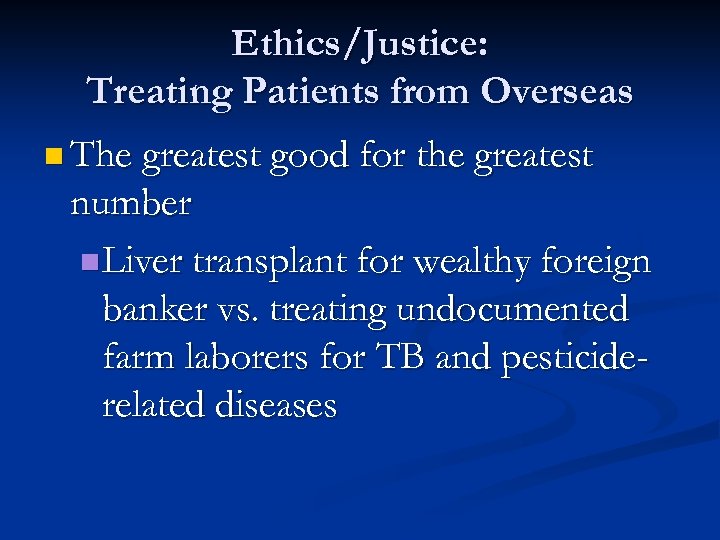 Ethics/Justice: Treating Patients from Overseas n The greatest good for the greatest number n Liver transplant for wealthy foreign banker vs. treating undocumented farm laborers for TB and pesticiderelated diseases
Ethics/Justice: Treating Patients from Overseas n The greatest good for the greatest number n Liver transplant for wealthy foreign banker vs. treating undocumented farm laborers for TB and pesticiderelated diseases
 Ethics/Justice: Treating Patients Overseas n Deploying medical students and physicians overseas to provide care and educate local practitioners in the care of respiratory and water-borne infectious diseases n Kill thousands worldwide each day
Ethics/Justice: Treating Patients Overseas n Deploying medical students and physicians overseas to provide care and educate local practitioners in the care of respiratory and water-borne infectious diseases n Kill thousands worldwide each day
 Ethics/Justice n Market forces have spurred for-profit health care companies to export the most inefficient, unjust elements of American medicine to the developing world
Ethics/Justice n Market forces have spurred for-profit health care companies to export the most inefficient, unjust elements of American medicine to the developing world
 The Medical Brain Drain n Migration of medical professionals from the developing world, where they were trained at public expense, to the US further depletes health care resources in poor countries and contributes to increasing inequities between rich and poor nations
The Medical Brain Drain n Migration of medical professionals from the developing world, where they were trained at public expense, to the US further depletes health care resources in poor countries and contributes to increasing inequities between rich and poor nations
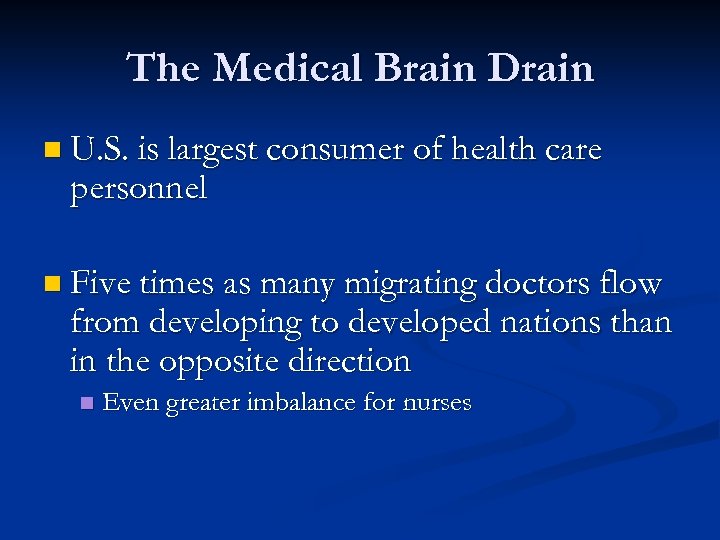 The Medical Brain Drain n U. S. is largest consumer of health care personnel n Five times as many migrating doctors flow from developing to developed nations than in the opposite direction n Even greater imbalance for nurses
The Medical Brain Drain n U. S. is largest consumer of health care personnel n Five times as many migrating doctors flow from developing to developed nations than in the opposite direction n Even greater imbalance for nurses
 The Medical Brain Drain n 2011: WHO estimates developing world shortage of 4. 3 million health professionals n Europe: 330 physicians/100 K population n US: 280/100 K n India: 60/100 K n Sub-Saharan Africa: 20/100 K
The Medical Brain Drain n 2011: WHO estimates developing world shortage of 4. 3 million health professionals n Europe: 330 physicians/100 K population n US: 280/100 K n India: 60/100 K n Sub-Saharan Africa: 20/100 K
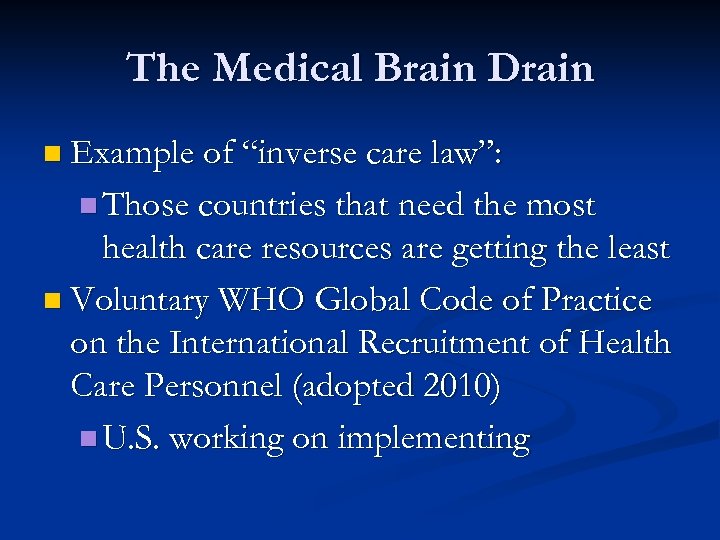 The Medical Brain Drain n Example of “inverse care law”: n Those countries that need the most health care resources are getting the least n Voluntary WHO Global Code of Practice on the International Recruitment of Health Care Personnel (adopted 2010) n U. S. working on implementing
The Medical Brain Drain n Example of “inverse care law”: n Those countries that need the most health care resources are getting the least n Voluntary WHO Global Code of Practice on the International Recruitment of Health Care Personnel (adopted 2010) n U. S. working on implementing
 LPC Clinics and The Erosion of Professional Ethics Public contributes substantially to the education and training of new physicians n May object to doctors limiting their practices to the wealthy, not accepting Medicare or Medicaid patients n
LPC Clinics and The Erosion of Professional Ethics Public contributes substantially to the education and training of new physicians n May object to doctors limiting their practices to the wealthy, not accepting Medicare or Medicaid patients n
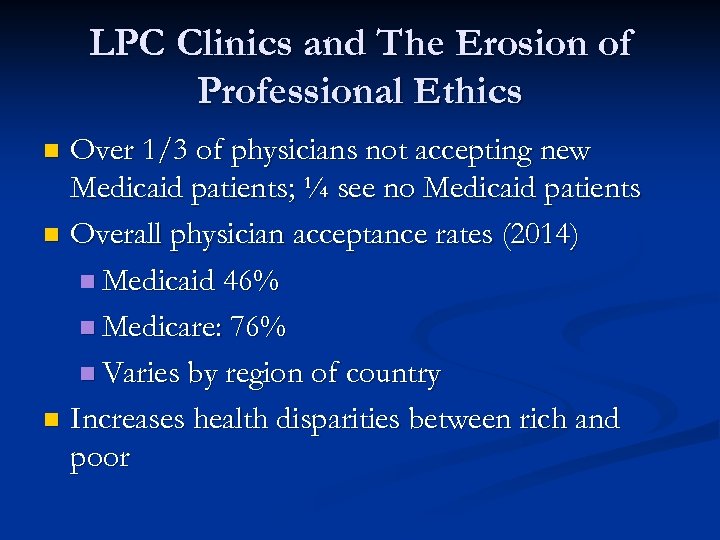 LPC Clinics and The Erosion of Professional Ethics Over 1/3 of physicians not accepting new Medicaid patients; ¼ see no Medicaid patients n Overall physician acceptance rates (2014) n Medicaid 46% n Medicare: 76% n Varies by region of country n Increases health disparities between rich and poor n
LPC Clinics and The Erosion of Professional Ethics Over 1/3 of physicians not accepting new Medicaid patients; ¼ see no Medicaid patients n Overall physician acceptance rates (2014) n Medicaid 46% n Medicare: 76% n Varies by region of country n Increases health disparities between rich and poor n
 LPC Clinics and The Erosion of Professional Ethics n Alternatively, debt-ridden physicians might justify limiting their practices to the wealthy by claiming a right to freely choose where they practice and for whom they care n Limits: HIV patients, racial prejudice
LPC Clinics and The Erosion of Professional Ethics n Alternatively, debt-ridden physicians might justify limiting their practices to the wealthy by claiming a right to freely choose where they practice and for whom they care n Limits: HIV patients, racial prejudice
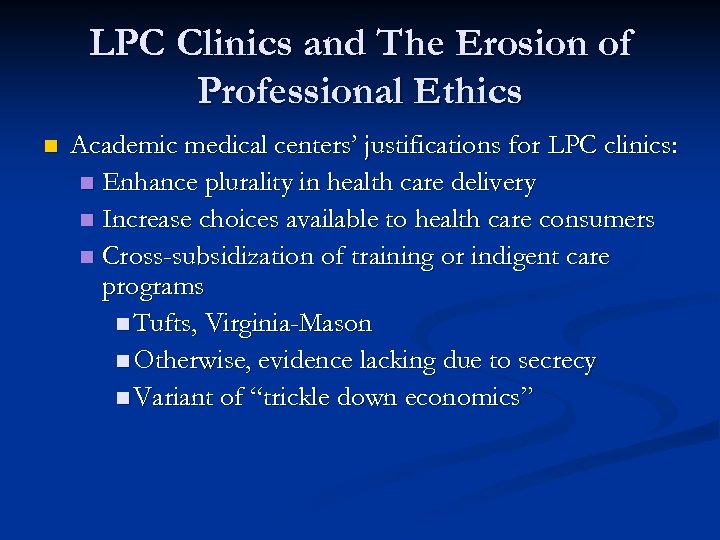 LPC Clinics and The Erosion of Professional Ethics n Academic medical centers’ justifications for LPC clinics: n Enhance plurality in health care delivery n Increase choices available to health care consumers n Cross-subsidization of training or indigent care programs n Tufts, Virginia-Mason n Otherwise, evidence lacking due to secrecy n Variant of “trickle down economics”
LPC Clinics and The Erosion of Professional Ethics n Academic medical centers’ justifications for LPC clinics: n Enhance plurality in health care delivery n Increase choices available to health care consumers n Cross-subsidization of training or indigent care programs n Tufts, Virginia-Mason n Otherwise, evidence lacking due to secrecy n Variant of “trickle down economics”
 LPC Clinics and The Erosion of Professional Ethics n AMA Guidelines: n Physicians switching to LPC practices must facilitate the transfer of patients who don’t pay retainers to other physicians n Shifts un- and poorly-compensated patient care onto fewer providers; risks domino effect n Dearth of primary care providers
LPC Clinics and The Erosion of Professional Ethics n AMA Guidelines: n Physicians switching to LPC practices must facilitate the transfer of patients who don’t pay retainers to other physicians n Shifts un- and poorly-compensated patient care onto fewer providers; risks domino effect n Dearth of primary care providers
 Physician Compensation (2015, From Medscape)
Physician Compensation (2015, From Medscape)
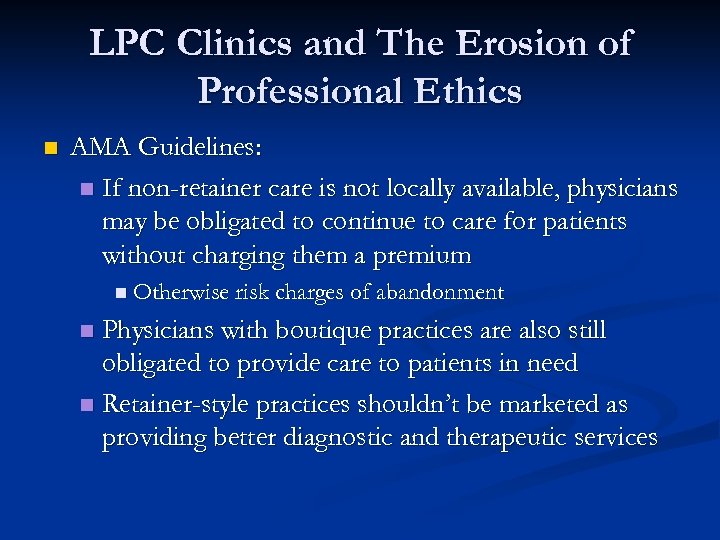 LPC Clinics and The Erosion of Professional Ethics n AMA Guidelines: n If non-retainer care is not locally available, physicians may be obligated to continue to care for patients without charging them a premium n Otherwise risk charges of abandonment Physicians with boutique practices are also still obligated to provide care to patients in need n Retainer-style practices shouldn’t be marketed as providing better diagnostic and therapeutic services n
LPC Clinics and The Erosion of Professional Ethics n AMA Guidelines: n If non-retainer care is not locally available, physicians may be obligated to continue to care for patients without charging them a premium n Otherwise risk charges of abandonment Physicians with boutique practices are also still obligated to provide care to patients in need n Retainer-style practices shouldn’t be marketed as providing better diagnostic and therapeutic services n
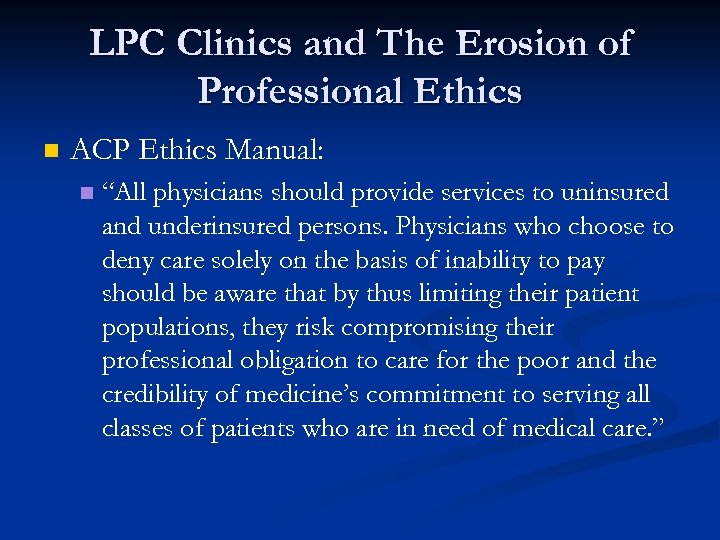 LPC Clinics and The Erosion of Professional Ethics n ACP Ethics Manual: n “All physicians should provide services to uninsured and underinsured persons. Physicians who choose to deny care solely on the basis of inability to pay should be aware that by thus limiting their patient populations, they risk compromising their professional obligation to care for the poor and the credibility of medicine’s commitment to serving all classes of patients who are in need of medical care. ”
LPC Clinics and The Erosion of Professional Ethics n ACP Ethics Manual: n “All physicians should provide services to uninsured and underinsured persons. Physicians who choose to deny care solely on the basis of inability to pay should be aware that by thus limiting their patient populations, they risk compromising their professional obligation to care for the poor and the credibility of medicine’s commitment to serving all classes of patients who are in need of medical care. ”
 Legal Risks of Boutique Practices n Violations of: Medicare regulations (prohibit charging Medicare beneficiaries additional fees for Medicare-covered services) n False Claims Act n Provider agreements with insurance companies n Anti-kickback statutes and other laws prohibiting payments to induce patient referrals n
Legal Risks of Boutique Practices n Violations of: Medicare regulations (prohibit charging Medicare beneficiaries additional fees for Medicare-covered services) n False Claims Act n Provider agreements with insurance companies n Anti-kickback statutes and other laws prohibiting payments to induce patient referrals n
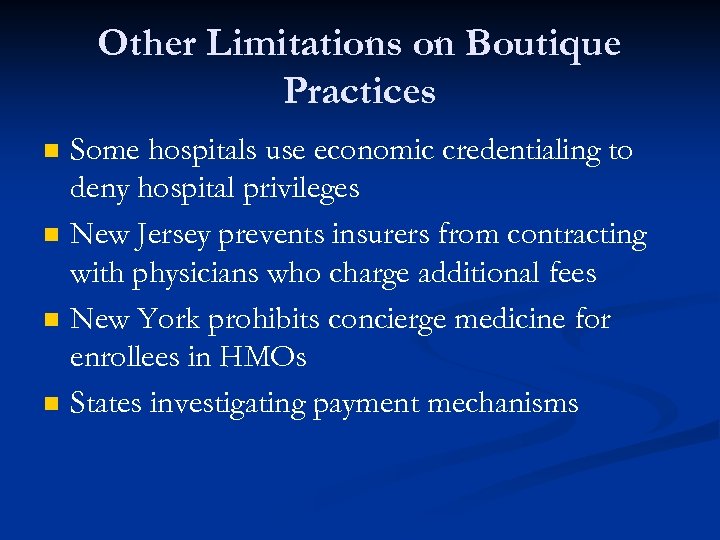 Other Limitations on Boutique Practices n n Some hospitals use economic credentialing to deny hospital privileges New Jersey prevents insurers from contracting with physicians who charge additional fees New York prohibits concierge medicine for enrollees in HMOs States investigating payment mechanisms
Other Limitations on Boutique Practices n n Some hospitals use economic credentialing to deny hospital privileges New Jersey prevents insurers from contracting with physicians who charge additional fees New York prohibits concierge medicine for enrollees in HMOs States investigating payment mechanisms
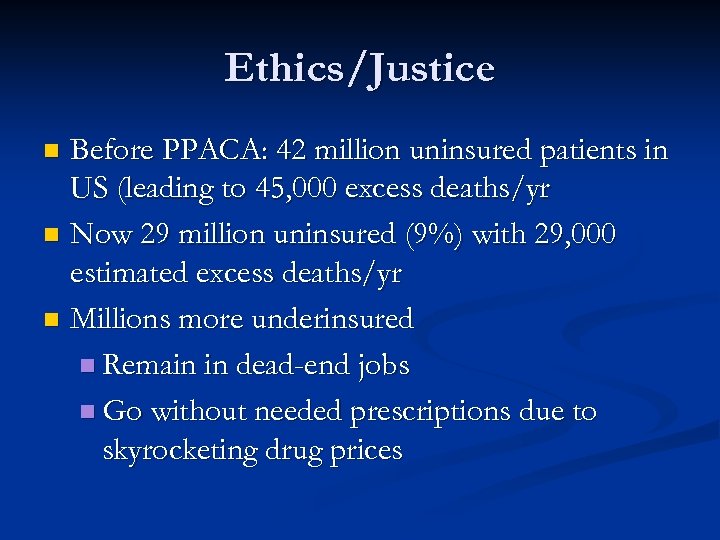 Ethics/Justice Before PPACA: 42 million uninsured patients in US (leading to 45, 000 excess deaths/yr n Now 29 million uninsured (9%) with 29, 000 estimated excess deaths/yr n Millions more underinsured n Remain in dead-end jobs n Go without needed prescriptions due to skyrocketing drug prices n
Ethics/Justice Before PPACA: 42 million uninsured patients in US (leading to 45, 000 excess deaths/yr n Now 29 million uninsured (9%) with 29, 000 estimated excess deaths/yr n Millions more underinsured n Remain in dead-end jobs n Go without needed prescriptions due to skyrocketing drug prices n
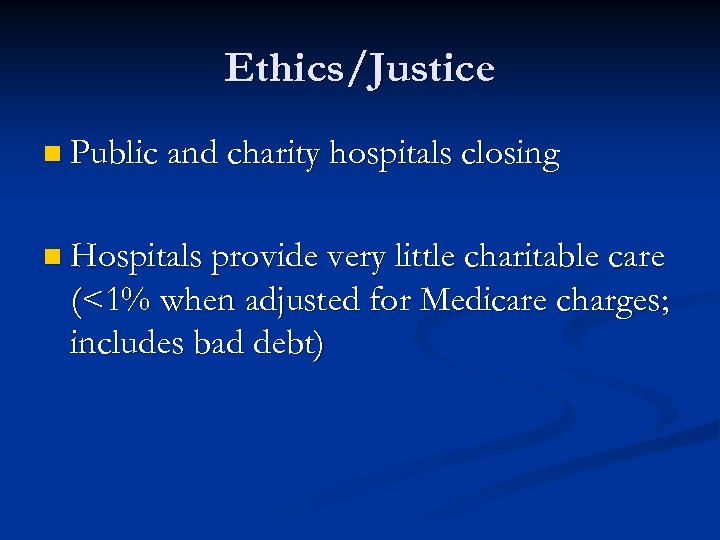 Ethics/Justice n Public and charity hospitals closing n Hospitals provide very little charitable care (<1% when adjusted for Medicare charges; includes bad debt)
Ethics/Justice n Public and charity hospitals closing n Hospitals provide very little charitable care (<1% when adjusted for Medicare charges; includes bad debt)
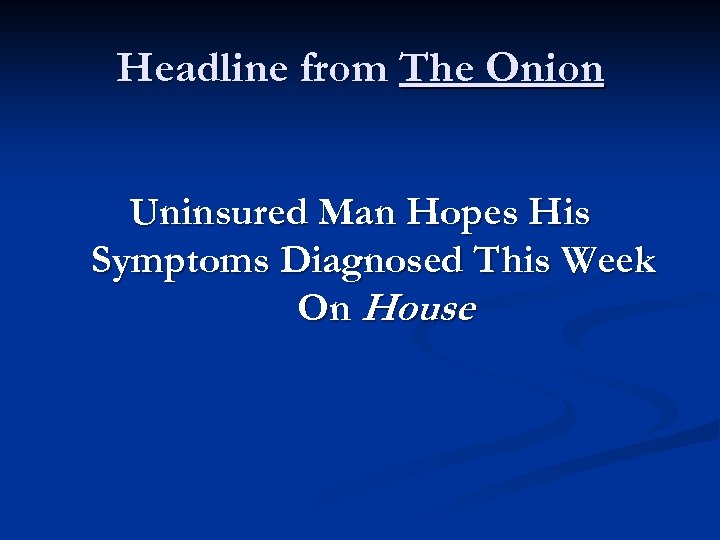 Headline from The Onion Uninsured Man Hopes His Symptoms Diagnosed This Week On House
Headline from The Onion Uninsured Man Hopes His Symptoms Diagnosed This Week On House
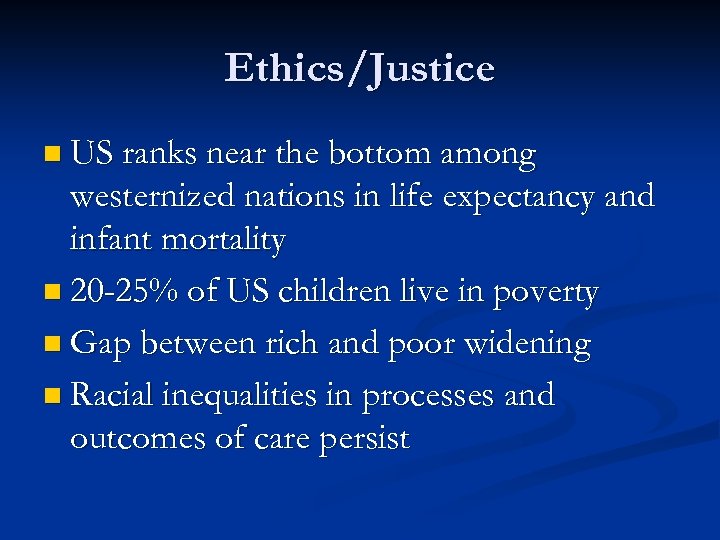 Ethics/Justice n US ranks near the bottom among westernized nations in life expectancy and infant mortality n 20 -25% of US children live in poverty n Gap between rich and poor widening n Racial inequalities in processes and outcomes of care persist
Ethics/Justice n US ranks near the bottom among westernized nations in life expectancy and infant mortality n 20 -25% of US children live in poverty n Gap between rich and poor widening n Racial inequalities in processes and outcomes of care persist
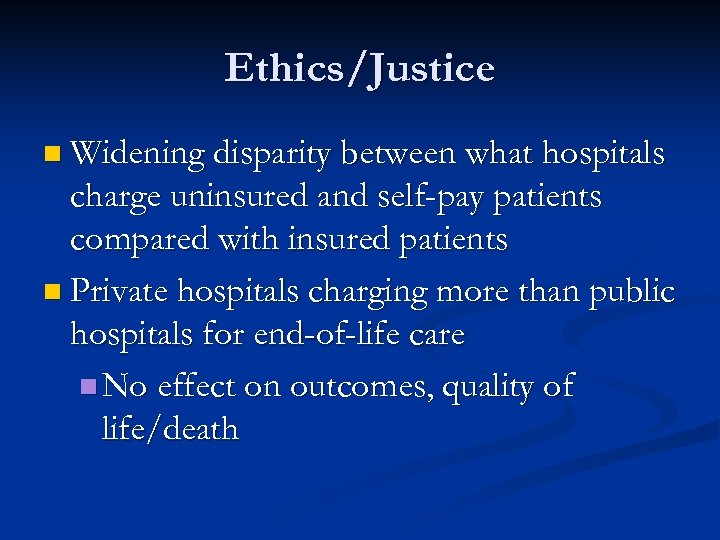 Ethics/Justice n Widening disparity between what hospitals charge uninsured and self-pay patients compared with insured patients n Private hospitals charging more than public hospitals for end-of-life care n No effect on outcomes, quality of life/death
Ethics/Justice n Widening disparity between what hospitals charge uninsured and self-pay patients compared with insured patients n Private hospitals charging more than public hospitals for end-of-life care n No effect on outcomes, quality of life/death
 Declaration of Independence “All men are created equal. ”
Declaration of Independence “All men are created equal. ”
 George Orwell “Some people are more equal than others”
George Orwell “Some people are more equal than others”
 Hudson River, 2009
Hudson River, 2009
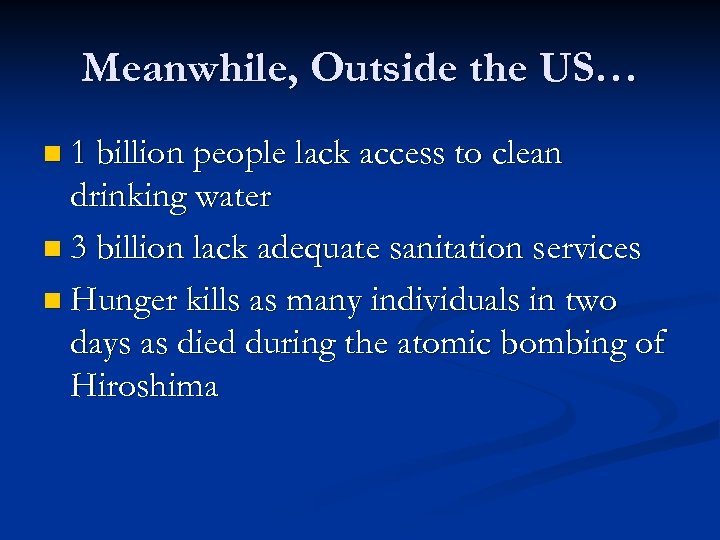 Meanwhile, Outside the US… n 1 billion people lack access to clean drinking water n 3 billion lack adequate sanitation services n Hunger kills as many individuals in two days as died during the atomic bombing of Hiroshima
Meanwhile, Outside the US… n 1 billion people lack access to clean drinking water n 3 billion lack adequate sanitation services n Hunger kills as many individuals in two days as died during the atomic bombing of Hiroshima
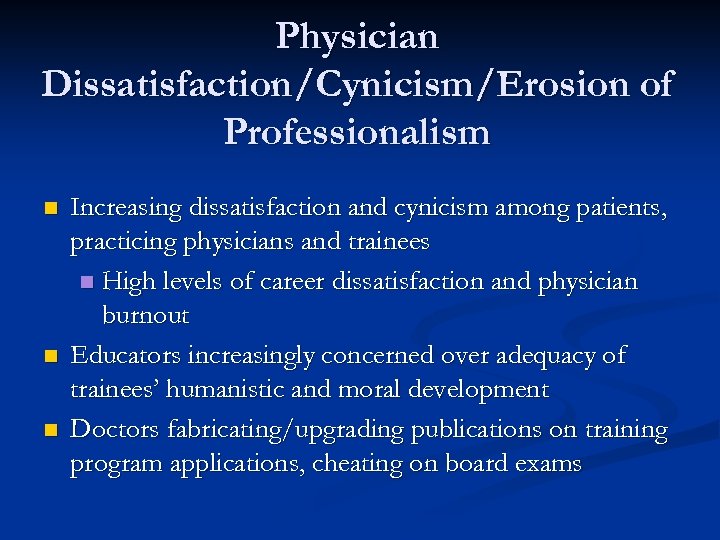 Physician Dissatisfaction/Cynicism/Erosion of Professionalism n n n Increasing dissatisfaction and cynicism among patients, practicing physicians and trainees n High levels of career dissatisfaction and physician burnout Educators increasingly concerned over adequacy of trainees’ humanistic and moral development Doctors fabricating/upgrading publications on training program applications, cheating on board exams
Physician Dissatisfaction/Cynicism/Erosion of Professionalism n n n Increasing dissatisfaction and cynicism among patients, practicing physicians and trainees n High levels of career dissatisfaction and physician burnout Educators increasingly concerned over adequacy of trainees’ humanistic and moral development Doctors fabricating/upgrading publications on training program applications, cheating on board exams
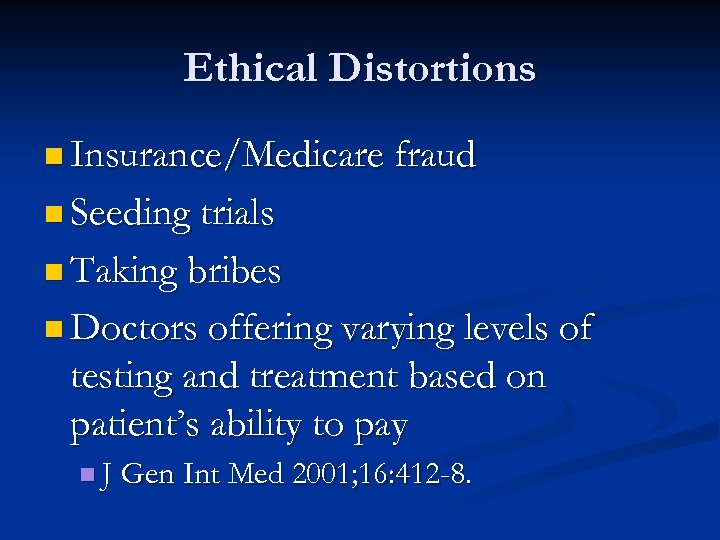 Ethical Distortions n Insurance/Medicare fraud n Seeding trials n Taking bribes n Doctors offering varying levels of testing and treatment based on patient’s ability to pay n J Gen Int Med 2001; 16: 412 -8.
Ethical Distortions n Insurance/Medicare fraud n Seeding trials n Taking bribes n Doctors offering varying levels of testing and treatment based on patient’s ability to pay n J Gen Int Med 2001; 16: 412 -8.
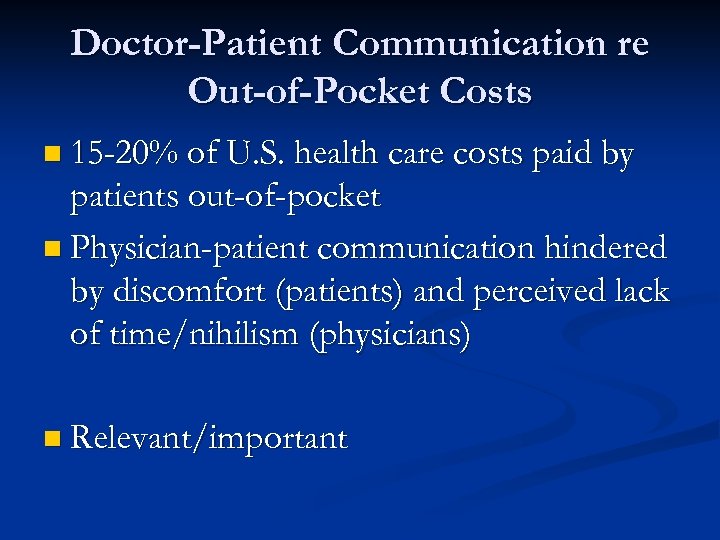 Doctor-Patient Communication re Out-of-Pocket Costs n 15 -20% of U. S. health care costs paid by patients out-of-pocket n Physician-patient communication hindered by discomfort (patients) and perceived lack of time/nihilism (physicians) n Relevant/important
Doctor-Patient Communication re Out-of-Pocket Costs n 15 -20% of U. S. health care costs paid by patients out-of-pocket n Physician-patient communication hindered by discomfort (patients) and perceived lack of time/nihilism (physicians) n Relevant/important
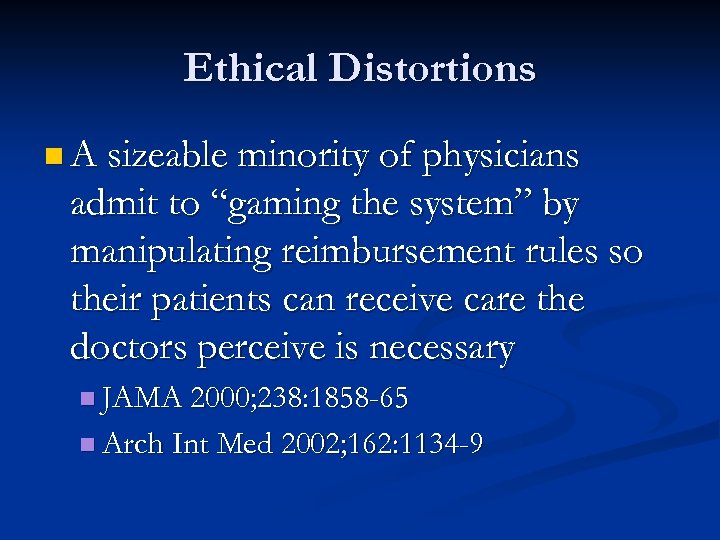 Ethical Distortions n A sizeable minority of physicians admit to “gaming the system” by manipulating reimbursement rules so their patients can receive care the doctors perceive is necessary n JAMA 2000; 238: 1858 -65 n Arch Int Med 2002; 162: 1134 -9
Ethical Distortions n A sizeable minority of physicians admit to “gaming the system” by manipulating reimbursement rules so their patients can receive care the doctors perceive is necessary n JAMA 2000; 238: 1858 -65 n Arch Int Med 2002; 162: 1134 -9
 Ethical Distortions n ¼ of the public sanctions deception (½ of those who believe doctors have inadequate time to appeal coverage decisions) n Ann Int Med 2003; 138: 472 -5 n Am J Bioethics 2004; 4(4): 1 -7
Ethical Distortions n ¼ of the public sanctions deception (½ of those who believe doctors have inadequate time to appeal coverage decisions) n Ann Int Med 2003; 138: 472 -5 n Am J Bioethics 2004; 4(4): 1 -7
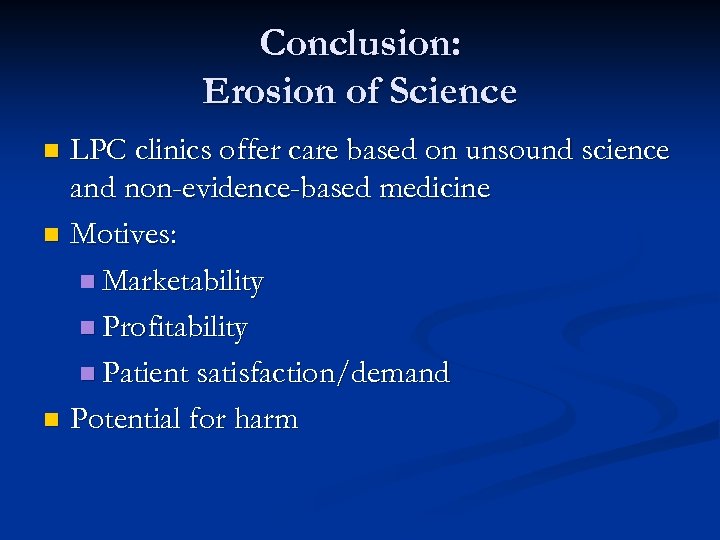 Conclusion: Erosion of Science LPC clinics offer care based on unsound science and non-evidence-based medicine n Motives: n Marketability n Profitability n Patient satisfaction/demand n Potential for harm n
Conclusion: Erosion of Science LPC clinics offer care based on unsound science and non-evidence-based medicine n Motives: n Marketability n Profitability n Patient satisfaction/demand n Potential for harm n
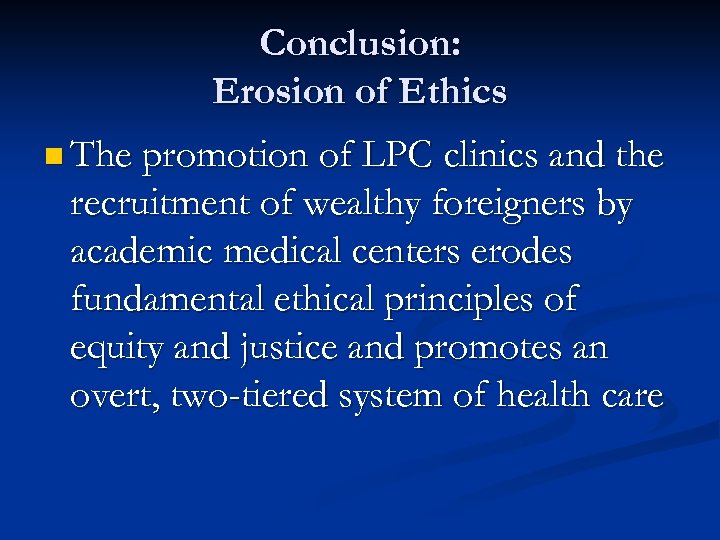 Conclusion: Erosion of Ethics n The promotion of LPC clinics and the recruitment of wealthy foreigners by academic medical centers erodes fundamental ethical principles of equity and justice and promotes an overt, two-tiered system of health care
Conclusion: Erosion of Ethics n The promotion of LPC clinics and the recruitment of wealthy foreigners by academic medical centers erodes fundamental ethical principles of equity and justice and promotes an overt, two-tiered system of health care
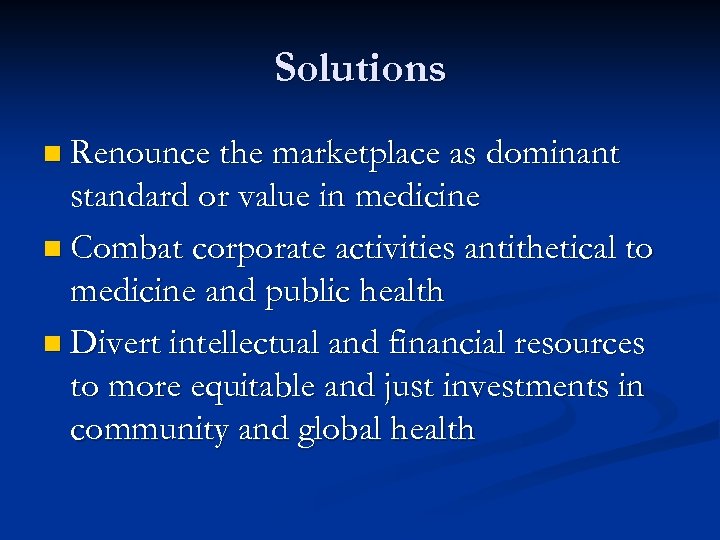 Solutions n Renounce the marketplace as dominant standard or value in medicine n Combat corporate activities antithetical to medicine and public health n Divert intellectual and financial resources to more equitable and just investments in community and global health
Solutions n Renounce the marketplace as dominant standard or value in medicine n Combat corporate activities antithetical to medicine and public health n Divert intellectual and financial resources to more equitable and just investments in community and global health
 Address Social Factors Responsible for Illness and Death n Deaths in 2000 attributable to: n Low education: 245, 000 n Racial segregation: 176, 000 n Low social support: 162, 000 n Individual-level poverty: 133, 000 n Income inequality: 119, 000 (population-attributable mortality – 5. 1%) n Area-level poverty: 39, 000 (population-attributable mortality – 1. 7%) (AJPH 2011; 101: 1456 -1465)
Address Social Factors Responsible for Illness and Death n Deaths in 2000 attributable to: n Low education: 245, 000 n Racial segregation: 176, 000 n Low social support: 162, 000 n Individual-level poverty: 133, 000 n Income inequality: 119, 000 (population-attributable mortality – 5. 1%) n Area-level poverty: 39, 000 (population-attributable mortality – 1. 7%) (AJPH 2011; 101: 1456 -1465)
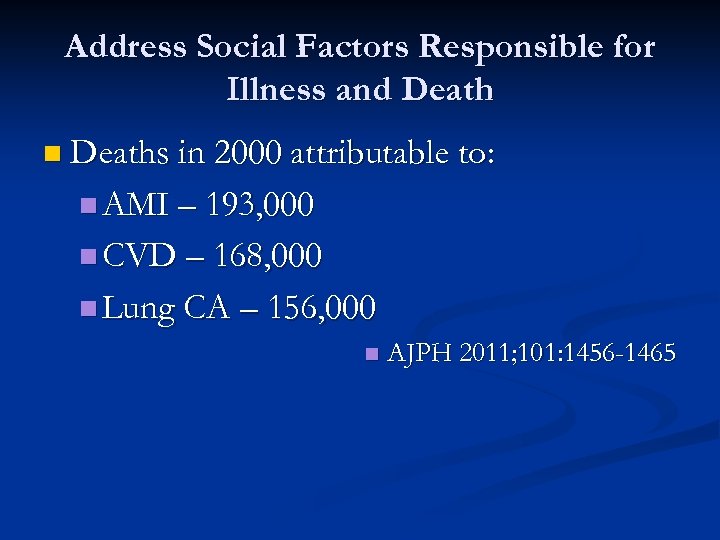 Address Social Factors Responsible for Illness and Death n Deaths in 2000 attributable to: n AMI – 193, 000 n CVD – 168, 000 n Lung CA – 156, 000 n AJPH 2011; 101: 1456 -1465
Address Social Factors Responsible for Illness and Death n Deaths in 2000 attributable to: n AMI – 193, 000 n CVD – 168, 000 n Lung CA – 156, 000 n AJPH 2011; 101: 1456 -1465
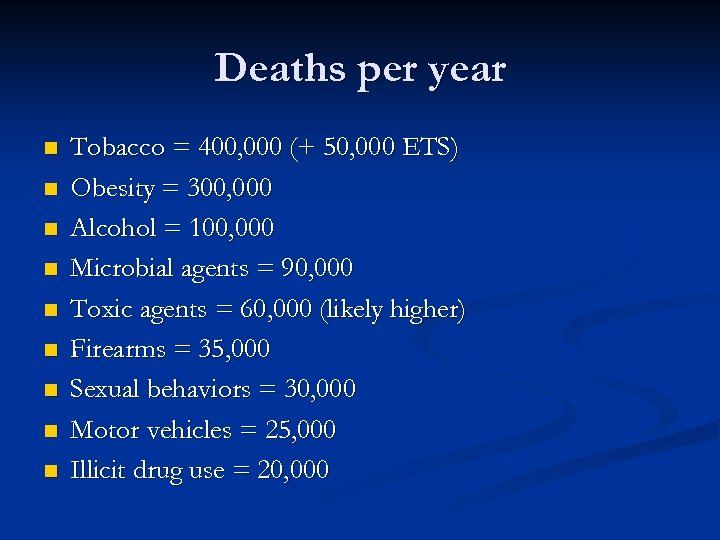 Deaths per year n n n n n Tobacco = 400, 000 (+ 50, 000 ETS) Obesity = 300, 000 Alcohol = 100, 000 Microbial agents = 90, 000 Toxic agents = 60, 000 (likely higher) Firearms = 35, 000 Sexual behaviors = 30, 000 Motor vehicles = 25, 000 Illicit drug use = 20, 000
Deaths per year n n n n n Tobacco = 400, 000 (+ 50, 000 ETS) Obesity = 300, 000 Alcohol = 100, 000 Microbial agents = 90, 000 Toxic agents = 60, 000 (likely higher) Firearms = 35, 000 Sexual behaviors = 30, 000 Motor vehicles = 25, 000 Illicit drug use = 20, 000
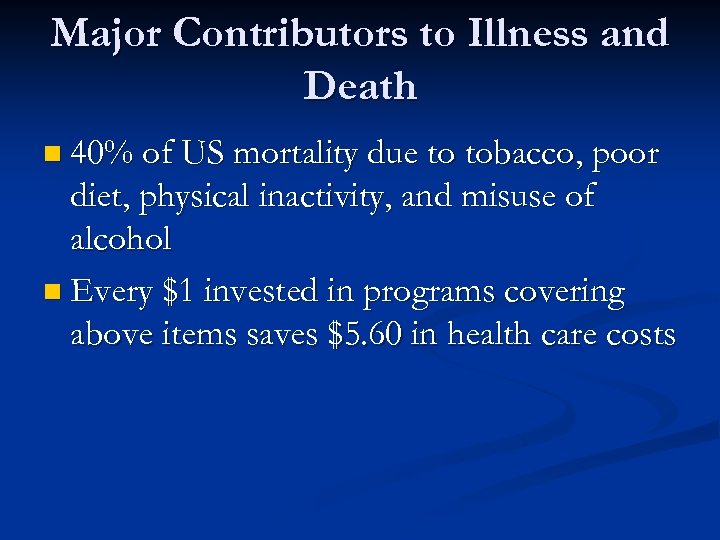 Major Contributors to Illness and Death n 40% of US mortality due to tobacco, poor diet, physical inactivity, and misuse of alcohol n Every $1 invested in programs covering above items saves $5. 60 in health care costs
Major Contributors to Illness and Death n 40% of US mortality due to tobacco, poor diet, physical inactivity, and misuse of alcohol n Every $1 invested in programs covering above items saves $5. 60 in health care costs
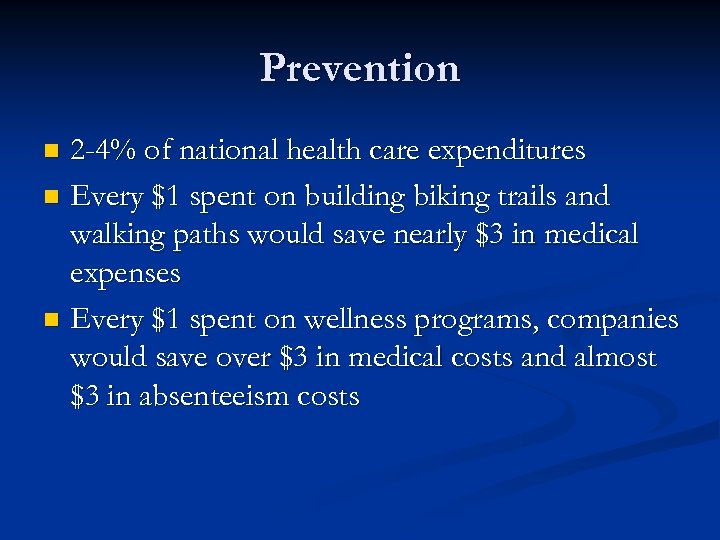 Prevention 2 -4% of national health care expenditures n Every $1 spent on building biking trails and walking paths would save nearly $3 in medical expenses n Every $1 spent on wellness programs, companies would save over $3 in medical costs and almost $3 in absenteeism costs n
Prevention 2 -4% of national health care expenditures n Every $1 spent on building biking trails and walking paths would save nearly $3 in medical expenses n Every $1 spent on wellness programs, companies would save over $3 in medical costs and almost $3 in absenteeism costs n
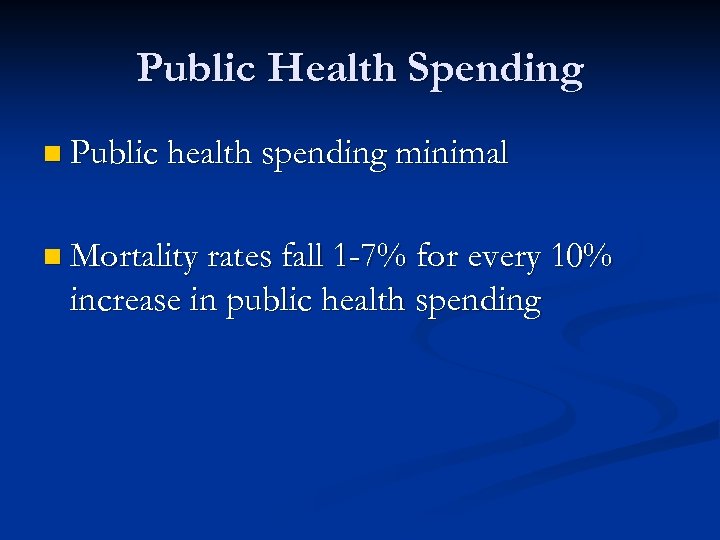 Public Health Spending n Public health spending minimal n Mortality rates fall 1 -7% for every 10% increase in public health spending
Public Health Spending n Public health spending minimal n Mortality rates fall 1 -7% for every 10% increase in public health spending
 Maldistribution of Wealth is Deadly n 880, 000 deaths/yr in U. S. would be averted if the country had an income gap like Western European nations, with their stronger social safety nets n BMJ 2009; 339: b 4471
Maldistribution of Wealth is Deadly n 880, 000 deaths/yr in U. S. would be averted if the country had an income gap like Western European nations, with their stronger social safety nets n BMJ 2009; 339: b 4471
 Address Racial Disparities in Health Care n Equalizing the mortality rates of whites and African-Americans would have averted 686, 202 deaths between 1991 and 2000 n Whereas medical advances averted 176, 633 deaths (AJPH 2004; 94: 2078 -2081)
Address Racial Disparities in Health Care n Equalizing the mortality rates of whites and African-Americans would have averted 686, 202 deaths between 1991 and 2000 n Whereas medical advances averted 176, 633 deaths (AJPH 2004; 94: 2078 -2081)
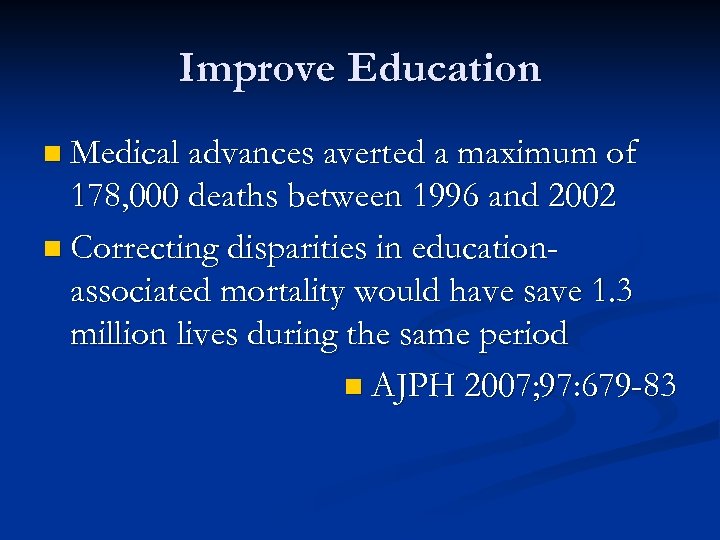 Improve Education n Medical advances averted a maximum of 178, 000 deaths between 1996 and 2002 n Correcting disparities in educationassociated mortality would have save 1. 3 million lives during the same period n AJPH 2007; 97: 679 -83
Improve Education n Medical advances averted a maximum of 178, 000 deaths between 1996 and 2002 n Correcting disparities in educationassociated mortality would have save 1. 3 million lives during the same period n AJPH 2007; 97: 679 -83
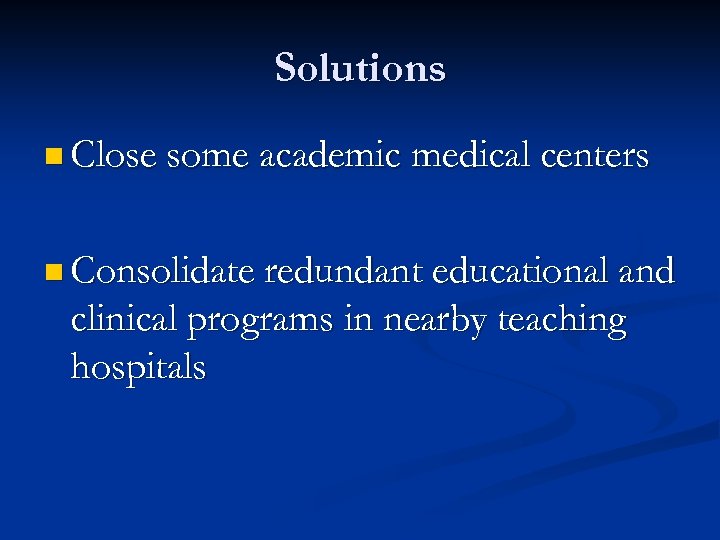 Solutions n Close some academic medical centers n Consolidate redundant educational and clinical programs in nearby teaching hospitals
Solutions n Close some academic medical centers n Consolidate redundant educational and clinical programs in nearby teaching hospitals
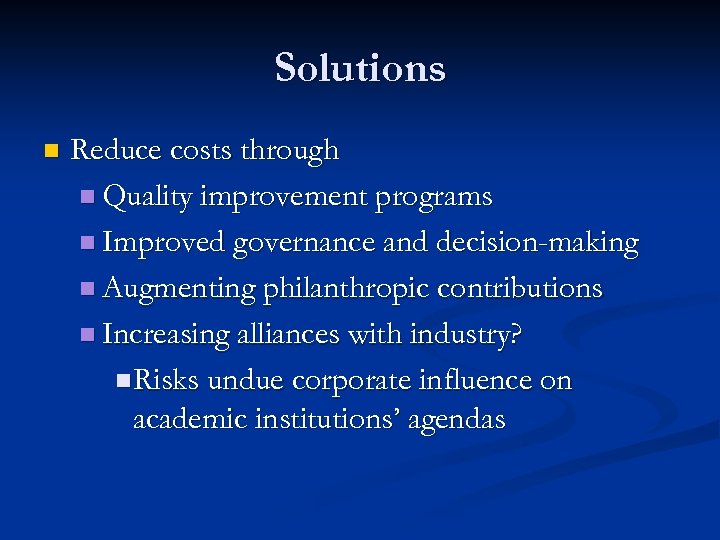 Solutions n Reduce costs through n Quality improvement programs n Improved governance and decision-making n Augmenting philanthropic contributions n Increasing alliances with industry? n Risks undue corporate influence on academic institutions’ agendas
Solutions n Reduce costs through n Quality improvement programs n Improved governance and decision-making n Augmenting philanthropic contributions n Increasing alliances with industry? n Risks undue corporate influence on academic institutions’ agendas
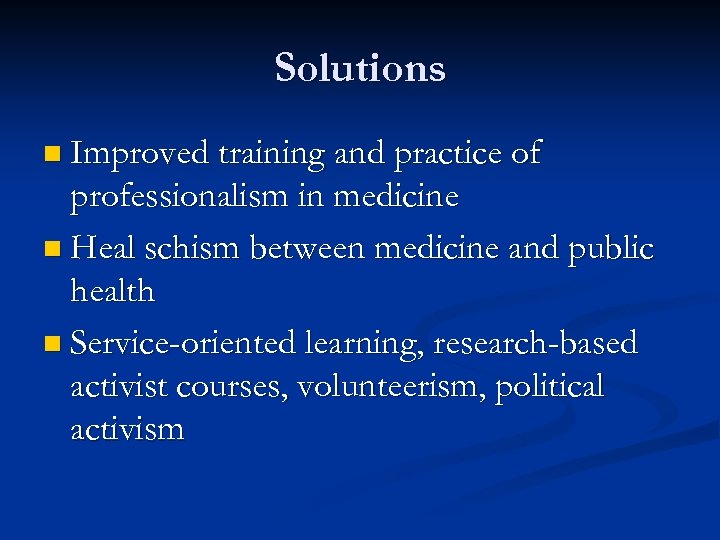 Solutions n Improved training and practice of professionalism in medicine n Heal schism between medicine and public health n Service-oriented learning, research-based activist courses, volunteerism, political activism
Solutions n Improved training and practice of professionalism in medicine n Heal schism between medicine and public health n Service-oriented learning, research-based activist courses, volunteerism, political activism
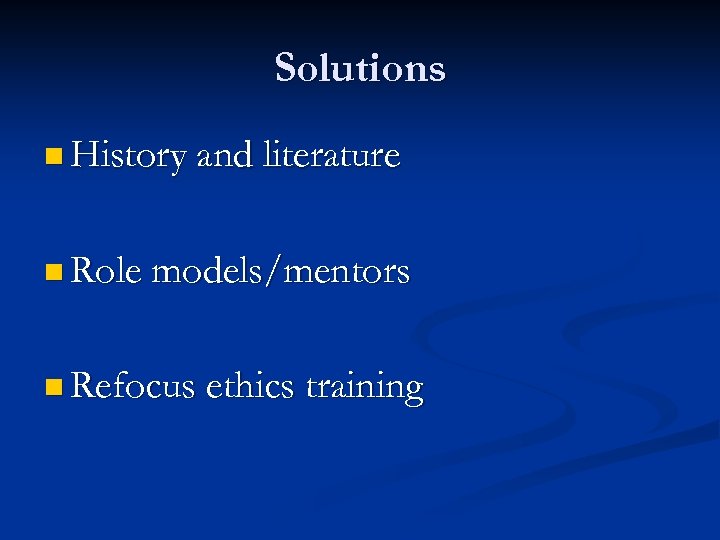 Solutions n History and literature n Role models/mentors n Refocus ethics training
Solutions n History and literature n Role models/mentors n Refocus ethics training
 Solutions n Empathic and equal provision of care to all individuals, regardless of insurance status, financial resources, race, gender, or sexual orientation n Confront and work to abolish the reality of rationing; promote equal access and care in all spheres of medicine
Solutions n Empathic and equal provision of care to all individuals, regardless of insurance status, financial resources, race, gender, or sexual orientation n Confront and work to abolish the reality of rationing; promote equal access and care in all spheres of medicine
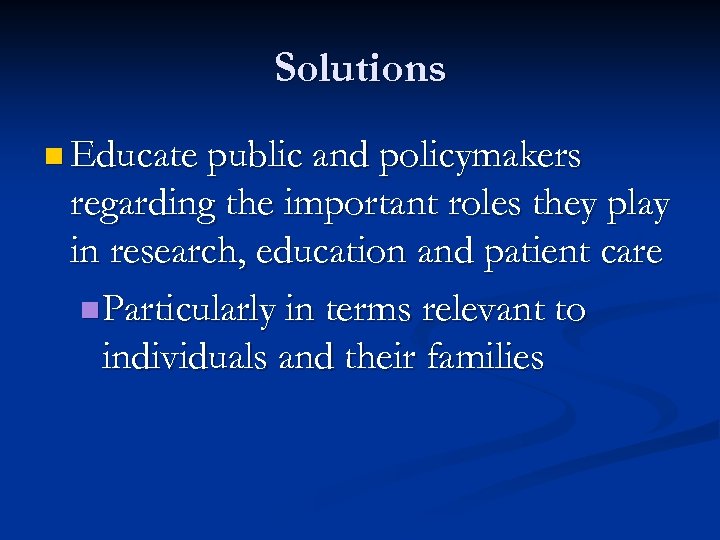 Solutions n Educate public and policymakers regarding the important roles they play in research, education and patient care n Particularly in terms relevant to individuals and their families
Solutions n Educate public and policymakers regarding the important roles they play in research, education and patient care n Particularly in terms relevant to individuals and their families
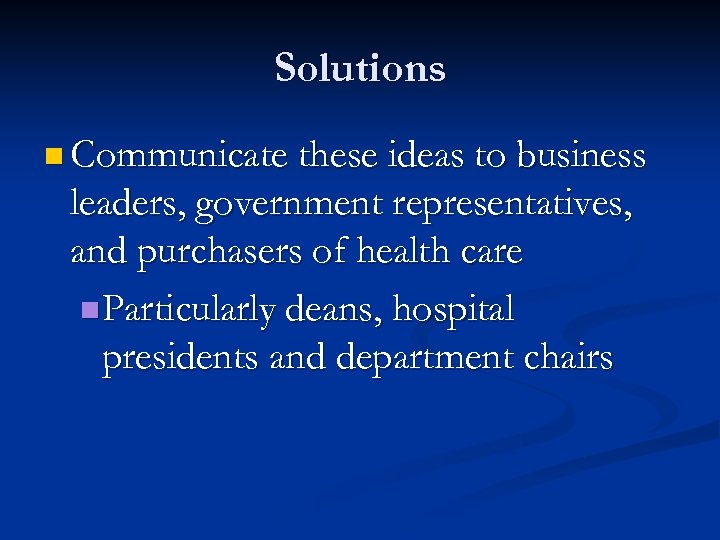 Solutions n Communicate these ideas to business leaders, government representatives, and purchasers of health care n Particularly deans, hospital presidents and department chairs
Solutions n Communicate these ideas to business leaders, government representatives, and purchasers of health care n Particularly deans, hospital presidents and department chairs
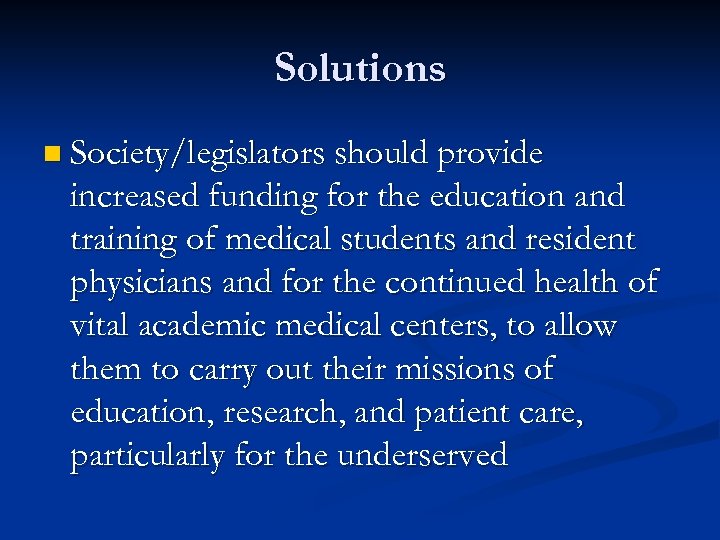 Solutions n Society/legislators should provide increased funding for the education and training of medical students and resident physicians and for the continued health of vital academic medical centers, to allow them to carry out their missions of education, research, and patient care, particularly for the underserved
Solutions n Society/legislators should provide increased funding for the education and training of medical students and resident physicians and for the continued health of vital academic medical centers, to allow them to carry out their missions of education, research, and patient care, particularly for the underserved
 Primo Levi “A country is considered the more civilized the more the wisdom and efficiency of its laws hinder a weak man from becoming too weak or a powerful one too powerful. ”
Primo Levi “A country is considered the more civilized the more the wisdom and efficiency of its laws hinder a weak man from becoming too weak or a powerful one too powerful. ”
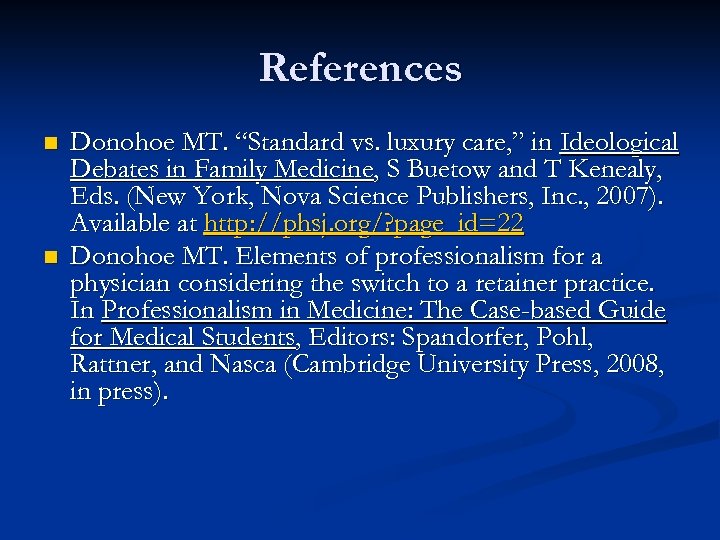 References n n Donohoe MT. “Standard vs. luxury care, ” in Ideological Debates in Family Medicine, S Buetow and T Kenealy, Eds. (New York, Nova Science Publishers, Inc. , 2007). Available at http: //phsj. org/? page_id=22 Donohoe MT. Elements of professionalism for a physician considering the switch to a retainer practice. In Professionalism in Medicine: The Case-based Guide for Medical Students, Editors: Spandorfer, Pohl, Rattner, and Nasca (Cambridge University Press, 2008, in press).
References n n Donohoe MT. “Standard vs. luxury care, ” in Ideological Debates in Family Medicine, S Buetow and T Kenealy, Eds. (New York, Nova Science Publishers, Inc. , 2007). Available at http: //phsj. org/? page_id=22 Donohoe MT. Elements of professionalism for a physician considering the switch to a retainer practice. In Professionalism in Medicine: The Case-based Guide for Medical Students, Editors: Spandorfer, Pohl, Rattner, and Nasca (Cambridge University Press, 2008, in press).
 References n n Donohoe MT. Luxury primary care, academic medical centers, and the erosion of science and professional ethics. J Gen Int Med 2004; 19: 90 -94. Available at http: //www. blackwellsynergy. com/doi/pdf/10. 1111/j. 15251497. 2004. 20631. x Donohoe MT. Retainer practice: Scientific issues, social justice, and ethical perspectives. American Medical Association Virtual Mentor 2004 (April); 6(4). Available at http: //www. amaassn. org/ama/pub/category/12249. html
References n n Donohoe MT. Luxury primary care, academic medical centers, and the erosion of science and professional ethics. J Gen Int Med 2004; 19: 90 -94. Available at http: //www. blackwellsynergy. com/doi/pdf/10. 1111/j. 15251497. 2004. 20631. x Donohoe MT. Retainer practice: Scientific issues, social justice, and ethical perspectives. American Medical Association Virtual Mentor 2004 (April); 6(4). Available at http: //www. amaassn. org/ama/pub/category/12249. html
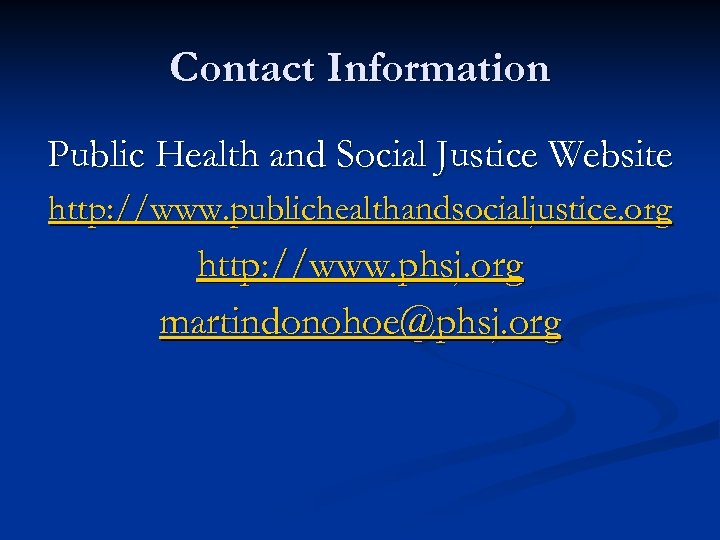 Contact Information Public Health and Social Justice Website http: //www. publichealthandsocialjustice. org http: //www. phsj. org martindonohoe@phsj. org
Contact Information Public Health and Social Justice Website http: //www. publichealthandsocialjustice. org http: //www. phsj. org martindonohoe@phsj. org
